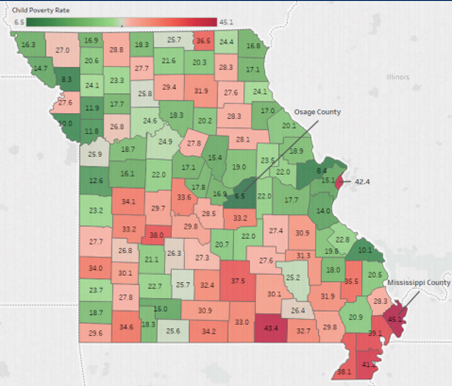Intergenerational Poverty in Missouri: Describing and Estimating the Scope of Cyclical Poverty
Bottom Line: Child poverty is falling in Missouri as a whole but rising in pockets like the bootheel, where income mobility is also low. Income mobility among the poor differs markedly by geographic zone. Zones with high rates of child poverty and low rates of expected upward mobility present unique policy challenges.
Some Missouri counties are faring better than others when it comes to child poverty. County-level poverty rates in Missouri range from less than 7 percent in Osage County to over 45 percent in Mississippi County. Between 2012 and 2016, the child poverty rates in Mississippi and Hickory counties increased by 17.2 and 18.1 percentage points, respectively. Conversely, Reynolds and Carter counties have seen significant reductions in child poverty of 17.5 and 18.7 percentage points, respectively.
Major urban areas — Springfield, Kansas City, and St. Louis — have much higher rates of poverty than the counties in which they are located. Therefore, it is important to look deeper than the county level.
Income mobility differs by geographic area. For poor children in the city of St. Louis, the probability of moving into the top quintile of incomes or higher was just 5.1 percent, compared to 12.1 percent for the lowest-income children who grew up around Bethany in northern Missouri. At the same time, the study showed that a substantial majority of low-income children in St. Louis (69 percent) would escape poverty in adulthood, while more than 80 percent of children from low-income families in Bethany would do so.
Low-income children from St. Louis with parents at the 25th percentile only move up to about the 32nd percentile of income distribution by the time they are 30 years old. On the other hand, children in families at the 25th percentile in Shelby County, on average, end up at almost the 55th percentile by the time they are about 30 years old. Not far behind Shelby County is Osage, with an absolute upward mobility expectation of 54.2.
Prosperous counties have low poverty rates and higher rates of educational attainment. Importantly, they have also been experiencing strong growth in jobs and businesses. At the other end of the spectrum, Wayne County lost almost one-fifth of its jobs and close to one-tenth of its business establishments within five years.
Read the full report here.
Missouri Child Poverty Rates by County

Findings:
- Child poverty is falling in Missouri as a whole but rising in pockets like the bootheel, where income mobility is also low.
- Between 2012 and 2016, the child poverty rates in Mississippi and Hickory counties increased by 17.2 and 18.1 percentage points, respectively. Conversely, Reynolds and Carter counties have seen significant reductions in child poverty of 17.5 and 18.7 percentage points, respectively.
- Income mobility differs by geographic area. For poor children in the city of St. Louis, the probability of moving into the top quintile of incomes or higher was just 5.1 percent, compared to 12.1 percent for the lowest-income children who grew up around Bethany in northern Missouri.



